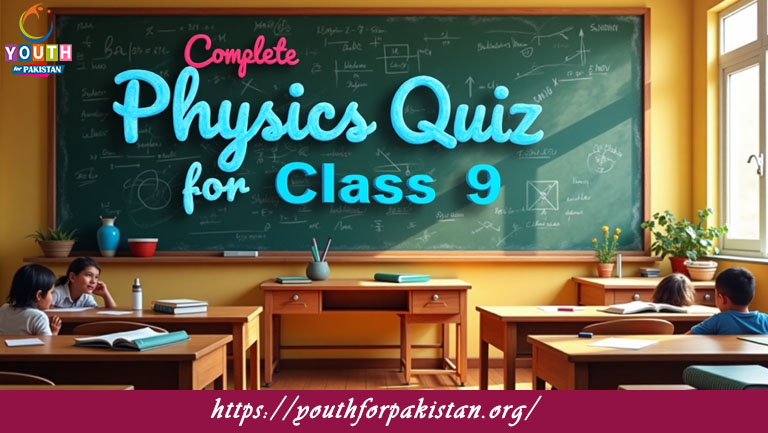Physics is an essential subject for MDCAT students, as it builds the foundation for advanced concepts in both medical and engineering studies. The 9th Class Physics Complete Quiz provides mastery of basic topics necessary to understand the subject better, including motion, forces, energy, waves, and properties of matter. This quiz will provide a thorough review of the major concepts to help students assess their understanding and prepare effectively for their exams. These quizzes actually help build confidence in students and ensure that a student is ready for both academic and entrance test challenges.
Core Topics Covered in the Quiz
The 9th Class Physics Complete Quiz includes questions on kinematics, Newton’s laws of motion, and work and energy. Students will encounter real-world problems that test their ability to apply physics principles to practical situations. Additionally, topics such as thermal properties of matter, oscillations, and wave phenomena are included to ensure a well-rounded understanding of the syllabus. This quiz is a perfect tool to enhance problem-solving skills and to solidify conceptual knowledge, making it a must-have resource for every MDCAT aspirant.
Quiz for Practice
The MDCAT Quiz for 9th Class Physics ensures students have access to high-quality, exam-oriented questions. It focuses on frequently tested topics, helping students understand the type of questions they may encounter in the actual test. Regular practice of these quizzes allows for better time management, quicker recall of formulas, and sharper analytical thinking. Practice quizzes can also reveal areas that need more attention, enabling targeted study sessions.
- Test Name: 9th Class Physics Complete Quiz
- Total Questions: 210
- Total Marks: 210
- Time: 105 minutes
Note: Answer of the questions will change randomly each time you start the test, once you are finished, click the View Results button.
0Get Your Username and Password for MDCAT Tests
Sign Up Now
Free Flashcard for Quick Revision
Alongside the quiz, students can use free flashcards for a quick and effective revision of essential formulas, laws, and definitions. These flashcards are tailored for 9th Class Physics topics, making them ideal for last-minute preparation. Flashcards are a proven tool to improve memory retention and ensure students can recall key points during their exams. By using these resources, students can maximize their performance and achieve top scores in their MDCAT.

What is the formula for Ohm's Law?

How many kilometers are in one mile?

What is the SI unit of capacitance?

What is the formula for acceleration?
Acceleration = Change in Velocity/Time

What is the measurement 4000 written in scientific notation?

What is the formula for work done?
Work Done = Force × Distance

How many meters are in one millimeter?

What is the SI unit of magnetic flux?

What is the formula for kinetic energy?
Kinetic Energy = 0.5 × Mass × Velocity²

How many nanoseconds are in one second?

What is the SI unit of force?

What is the formula for pressure?

How many milliliters are in one liter?

What is the SI unit of power?

How many grams are in one kilogram?

What is the formula for velocity?

What is the SI unit of frequency?

What is the volume of a cylinder with a radius of 3 centimeters and a height of 5 centimeters?

What is the speed of light in a vacuum?
Approximately 3.00 x 10⁸ meters per second

How many significant figures are in the measurement 0.00780?

What is the SI unit of electric potential?

What is the formula for density?

How many meters are in one kilometer?

What is the SI unit of luminous flux?

Which unit is used to measure the amount of substance?

What is the measurement 0.0056 written in scientific notation?

How many seconds are in one hour?

What is the SI unit of luminous intensity?

What is the volume of a cube with sides measuring 2 centimeters each?

Which instrument is used to measure electric resistance?

Which of the following is a property of gases?

The resistance of a material to scratching, abrasion, or indentation is called _____.

The property of a material to permanently change its shape under an applied force is called _____.

Which of the following materials is known for its high ductility?

Ductility is the property of a material to _____.

The property of a material to resist deformation under an applied force and return to its original shape when the force is removed is called _____.

The SI unit of viscosity is the _____ per second (Pa∙s).

Which of the following statements about atmospheric pressure is true?
Atmospheric pressure decreases with increasing altitude

Which of the following factors affect atmospheric pressure?

Atmospheric pressure at sea level is approximately _____ Pa.

Which of the following statements about pressure is true?
Pressure is force per unit area

The SI unit of pressure is the _____.

The force per unit area is called _____.

Which of the following statements about elasticity is true?
Elasticity is the property of a material to regain its original shape after deformation

The property of a material that enables it to return to its original shape and size after deformation is called _____.

Which of the following is a property of solids?

Which of the following statements about capillarity is true?
Capillarity is the rise or fall of a liquid in a narrow tube due to surface tension

The phenomenon by which a liquid rises in a narrow tube is called _____.

The upward force exerted by a fluid on an object immersed in it is called _____.

Which of the following is a property of liquids?

The latent heat of vaporization is the amount of heat required to _____.
Change a substance from liquid to gas

The latent heat of fusion is the amount of heat required to _____.
Change a substance from solid to liquid

Which of the following statements about specific heat is true?
Specific heat is the amount of heat required to change the temperature of a unit mass of a substance by one degree Celsius

The amount of heat required to raise the temperature of one gram of a substance by one degree Celsius is called _____.

Which of the following is a characteristic property of matter?

The change of state from liquid to gas is called _____.

Which of the following statements about freezing point is true?
Freezing point is the temperature at which a liquid turns into a solid

The freezing point of water at sea level is _____ Celsius.

Which of the following statements about boiling point is true?
Boiling point is the temperature at which a liquid turns into a gas

The boiling point of water at sea level is _____ Celsius.

The energy associated with the random motion of particles is called _____.

Which of the following is a renewable source of energy?

The potential energy of an object at rest on a table is _____.

The law of conservation of energy states that energy cannot be _____ or destroyed, only transformed from one form to another.

If the net work done on an object is positive, its kinetic energy will _____.

The energy associated with the motion of an object is called _____.

The gravitational potential energy of an object depends on its _____ and height above the reference level.

The work-energy theorem relates the work done on an object to the change in its _____.

Which of the following is a non-renewable source of energy?

The energy associated with the position of an object relative to a reference point is called _____.

The energy of motion is called _____.

The energy stored in food is an example of _____.
Chemical potential energy

Which of the following statements about energy is true?
Energy can neither be created nor destroyed

The rate of doing work or the rate of using energy is called _____.

Which of the following is a unit of power?

The power developed by a machine is the ratio of work done to the _____ taken to do the work.

Which of the following statements about power is true?
Power is the rate at which work is done or energy is transferred

The SI unit of power is the _____.

The work done by a force is negative if the force and the displacement are in _____ directions.

The total mechanical energy of a system is conserved when only _____ forces are acting on it.

Which of the following statements about potential energy is true?
Potential energy depends on the position of an object

The energy associated with the random motion of particles is called _____.

Friction converts mechanical energy into _____.

The energy possessed by a rolling ball is a combination of _____.
Kinetic and potential energy

Which of the following is a renewable source of energy?

The potential energy of an object at rest on a table is _____.

The law of conservation of energy states that energy cannot be _____ or destroyed, only transformed from one form to another.

If the net work done on an object is positive, its kinetic energy will _____.

The energy associated with the motion of an object is called _____.

The gravitational potential energy of an object depends on its _____ and height above the reference level.

If the magnitude of force acting on an object increases, the torque produced will _____.

Which of the following statements about torque is true?
It causes rotational motion

Torque is also known as the ____ of force.

The moment arm is the _____ from the axis of rotation to the point where the force is applied.

The SI unit of torque is the _____ meter (Nm).

Torque is a vector quantity because it has both magnitude and _____.

The turning effect of force is also known as _____.

A force of 20 N is applied at a distance of 2 meters from the axis of rotation. What is the torque produced?

Which of the following is a method to increase the torque produced by a force?
Increase the distance from the axis of rotation

The moment of a force is maximum when the force is applied _____ to the axis of rotation.

The moment arm of a force is the _____ from the axis of rotation to the line of action of the force.

A torque of 10 Nm is applied to a door with a moment arm of 0.5 meters. What is the magnitude of the force applied?

The torque required to produce an angular acceleration of 1 rad/s² in an object with a moment of inertia of 2 kgm² is _____ Nm.

Which of the following factors affects the torque produced by a force?

The moment of a force depends on its magnitude and its _____.
Distance from the axis of rotation

The turning effect of a force is maximum when the force is applied at a _____ to the direction of the lever arm.

If the magnitude of force acting on an object increases, the torque produced will _____.

Which of the following statements about torque is true?
It causes rotational motion

Torque is also known as the ____ of force.

The moment arm is the _____ from the axis of rotation to the point where the force is applied.

The SI unit of torque is the _____ meter (Nm).

Torque is a vector quantity because it has both magnitude and _____.

The turning effect of force is also known as _____.

A force of 20 N is applied at a distance of 2 meters from the axis of rotation. What is the torque produced?

Which of the following is a method to increase the torque produced by a force?
Increase the distance from the axis of rotation

The moment of a force is maximum when the force is applied _____ to the axis of rotation.

The moment arm of a force is the _____ from the axis of rotation to the line of action of the force.

A torque of 10 Nm is applied to a door with a moment arm of 0.5 meters. What is the magnitude of the force applied?

The torque required to produce an angular acceleration of 1 rad/s² in an object with a moment of inertia of 2 kgm² is _____ Nm.

Which of the following factors affects the torque produced by a force?

The force required to lift an object against gravity is called _____.

The force of gravity between two objects ____ as the distance between them increases.

In the absence of air resistance, objects of different masses fall to the ground with the same _____.

The weight of an object is the force exerted on it due to _____.

The force of gravity on Earth is approximately _____ m/s².

The gravitational force between two objects ____ as the mass of one of the objects increases.

Which of the following represents the relationship between force, mass, and acceleration?

The force required to lift an object against gravity is equal to its _____.

Which of the following statements about momentum is true?
Momentum is conserved in isolated systems

The tendency of an object to remain at rest or in motion at a constant velocity is called _____.

An object is in motion when its position changes relative to a _____ frame of reference.

Which of the following factors affects the magnitude of the gravitational force between two objects?

Which of the following is a unit of force?

The gravitational force between two objects ____ as the distance between them increases.

The acceleration due to gravity is approximately ____ near the surface of the Earth.

The weight of an object is the force exerted on it due to _____.

Gravitational force is weakest on the surface of _____.

The force of gravity between two objects depends on their masses and the _____.

Which of the following statements about gravitational force is true?
It acts between any two masses in the universe

Gravitational force is _____.

The gravitational force between two objects ____ with an increase in their masses.

An object's weight is different on different planets because _____.
The gravitational acceleration is different

The gravitational force between two objects ____ as the distance between them increases.

The mass of an object is a measure of its _____.

The force of gravity on an object is also known as its _____.

Gravitational force is an example of a _____ force.

The force required to lift an object against gravity is called _____.

Which of the following factors affects the gravitational force between two objects?

The acceleration due to gravity ____ with altitude.

The gravitational force between two objects ____ as the distance between them increases.

The force of gravity between two objects ____ as the mass of one of the objects increases.

In the absence of air resistance, objects of different masses fall to the ground with the same _____.

The weight of an object is the force exerted on it due to _____.

The acceleration due to gravity is _____ near the surface of the Earth.

The force of gravity on Earth is approximately _____ m/s².

Which of the following statements about friction is true?
Friction always opposes motion

The force required to maintain circular motion is called _____.

According to Newton's first law of motion, an object will remain at rest or in uniform motion in a straight line unless acted upon by a _____.

The force that allows a car to navigate a curve safely is called _____.

The force that opposes the motion of an object as it moves through a fluid is called _____.

The SI unit of force is the _____.

The force required to lift an object against gravity is called _____.

The gravitational force between two objects ____ as the distance between them increases.

Which of the following factors affects the gravitational force between two objects?

The net force acting on an object is equal to the rate of change of its _____.

An object is in mechanical equilibrium when the _______ acting on it sum up to zero.

Which of the following statements about momentum is true?
Momentum is a vector quantity

Which of the following is not a type of friction?

Which of the following is a non-contact force?

The force required to maintain an object at a constant velocity in the presence of opposing force is called _____.

Which of the following equations represents Newton's second law of motion?

If an object is moving with constant speed in a circular path, its acceleration is directed towards the ____ of the circle.

Which of the following statements about inertia is true?
An object with more mass has more inertia

The work done by a force is defined as the product of the force and the _____ moved in the direction of the force.

Which of the following represents the relationship between force, mass, and acceleration?

The force required to lift an object against gravity is equal to its _____.

Which of the following statements about momentum is true?
Momentum is conserved in isolated systems

The tendency of an object to remain at rest or in motion at a constant velocity is called _____.

An object is in motion when its position changes relative to a _____ frame of reference.

Which of the following factors affects the magnitude of the frictional force between two surfaces?

If a particle moves with a constant speed, then its acceleration is

A body moving along a curved path undergoes _______ motion.

The slope of the velocity-time graph gives

The total displacement of an object moving in a straight line can be determined from its

If a car accelerates uniformly from rest to 20 m/s in 5 seconds, its acceleration is

An object moving with uniform velocity is undergoing

The slope of a displacement-time graph gives

A particle moves in a straight line such that its displacement versus time graph is a straight line inclined at an angle to the time axis. The particle is moving with

The area under the speed-time graph represents

The motion of an object along a straight line is called

The velocity-time graph of a body is a straight line parallel to the time axis. This indicates that the body is

The gradient of a displacement-time graph represents

A body moving along a straight line undergoes __________ motion.

The change in velocity of an object is equal to the area under the

The distance covered by a body in unit time is called

Which of the following represents a scalar quantity?

An object is moving with a constant velocity if its
Position-time graph is a straight line

The acceleration due to gravity on the surface of the earth is approximately

Which of the following is a unit of acceleration?

The instantaneous acceleration of an object can be found from its

If a body moves with a constant velocity, then its acceleration is

A ball is thrown vertically upwards. At the highest point, its velocity is

An object moving with a constant speed must have

The SI unit of acceleration is

Which of the following statements is correct?
Acceleration is a vector quantity

A car accelerates uniformly from 10 m/s to 30 m/s in 5 seconds. Its acceleration is

Which of the following represents a vector quantity?

If a car moves with a constant speed of 60 km/h for 2 hours, its total distance covered is

The area under the acceleration-time graph gives

An object is moving with a constant velocity if its acceleration is




























































